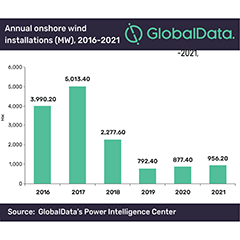The onshore wind sector in Germany has struggled throughout 2019, achieving only 792.40 megawatt (MW) of onshore wind installations. The lukewarm responses to wind auctions last year means that investors are going slow on project development until any change in local regulation is implemented, says GlobalData, a leading data and analytics company.
Mohit Prasad, Project Manager of Power at GlobalData says, “Annual installation of onshore wind capacity is expected to be subdued, with the country witnessing installations of less than 1 gigawatt (GW) per year in the near future. The country is expected to have onshore wind installations of 53.4GW at the end of 2019, with net annual installations of 792.4MW – considerably less than the 4GW average witnessed in 2014 and 2015 on the back of feed-in-tariffs.”
Following the switch to competitive auctions in 2017, Germany has witnessed a fall in its net annual installations. The flawed auction design and difficulties in obtaining licenses for turbine construction have discouraged investors, resulting in a lackluster performance of the auction mechanism.
Prasad added: “Construction of around 2,000 turbines with a combined capacity of 11GW is currently on hold on account of licensing issues. These issues mainly pertain to what mandatory minimum distance a project must be from residential areas and aviation infrastructure. The state of Bavaria, which has mandated that the distance between a wind turbine and the nearest housing must be ten times the height of the mast is not seeing any new wind power development. In the meanwhile, Brandenburg has passed a law that wind farm operators have to pay $11,100 per turbine each year to communities if a project is operating within three kilometers.
“With the last nuclear power plant in Germany to be shut down in 2022, and the coal power plants to be phased out by 2038, the country is aiming to get 65% of its power from wind, solar and other renewable energy sources by 2030.
“The onshore wind industry contributed around 25% to the power mix of country in 2018, which definitely has to increase if the country wants to be carbon neutral by 2050. This can be achieved by promoting wind and solar technologies.
“In order to achieve their climate target, Germany needs to add an average of 4.7GW of new onshore wind power capacity each year from now until 2050. This can be addressed by making amendments to the existing auction mechanism and project licensing for onshore wind projects.”
About GlobalData
4,000 of the world’s largest companies, including over 70% of FTSE 100 and 60% of Fortune 100 companies, make more timely and better business decisions thanks to GlobalData’s unique data, expert analysis and innovative solutions, all in one platform. GlobalData’s mission is to help our clients decode the future to be more successful and innovative across a range of industries, including the healthcare, consumer, retail, financial, technology and professional services sectors.


























